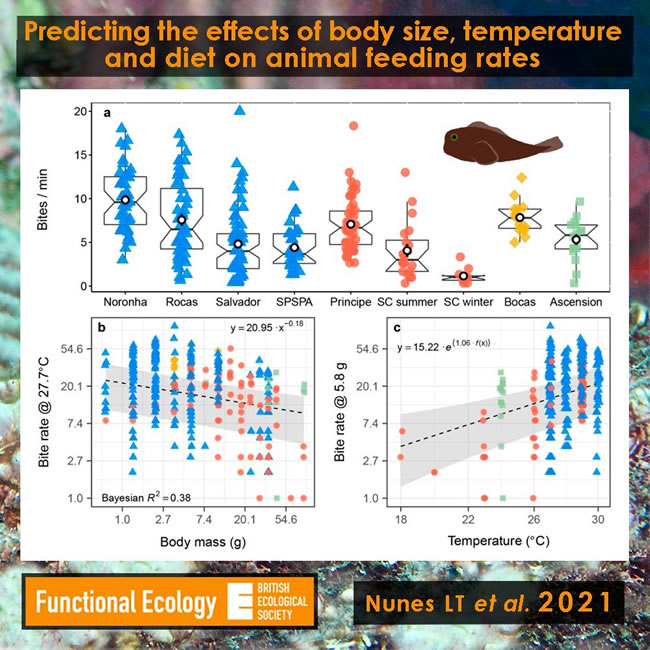|
New Paper: The feeding rate of reef fishes
Many reef fishes feed constantly at the bottom of the reef from where they garner different types of food such as
detritus, algae and invertebrates. Food consumption is extremely important for fish to achieve their energy targets,
grow and reproduce. Unfortunately, quantifying fish food consumption in the field is challenging because they are
highly mobile organisms. Consequently, scientists often have to rely on a proxy for consumption rates by counting
how many bites per unit time (a.k.a. bite rates) a fish allocates to different food items. There is extensive theory on
how consumption rates should change with varying body size and the surrounding environmental temperature.
However, we still lack a framework to mathematically link consumption rates to bite rates. In our study, we propose
a mathematical framework to link bite rates to consumption rates, and in doing so we establish predictions about
how bite rates should change with the size of the individual and environmental temperature. Using our model as a
point of departure, we quantified how body size, water temperature and diet influence the bite rates of small cryptic
marine fishes from the genus Ophioblennius (redlip blennies). We then used these estimates to simulate how
climate change might affect consumption rates. We tallied the bite rates of four Ophioblennius species in eight
locations across the Atlantic Ocean. We found that fishes speed up their bite rates with increasing water
temperature—more so than expected by our model; moreover, at a given temperature, smaller individuals exhibited
faster bite rates than larger individuals. We found that detritus made up most of the diet of multiple Ophioblennius
populations (belonging to two species) by sampling the stomach contents of individuals. Algae and animals were
also found but in much smaller quantities, probably suggesting accidental ingestion. In testing our predictions with
laboratory data and field observations from a broad geographical range we can better understand the effects of
environmental change on consumers’ feeding pressure. Based on our results, we simulated how ocean warming
might affect consumption rates, and discovered that the combined effects of smaller sizes and higher temperatures
will considerably increase the consumption rates of these animals, which means that each individual will require
much more food. Because these abundant cryptic fish are prey to many predators on the reef, our study suggests
that climate change will limit the amount of food (energy) that moves from algae to predators in marine food webs.
Image and text by Lucas Nunes


|









